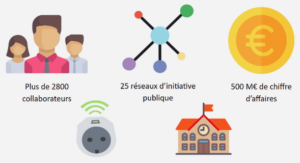Classification du neuroblastome
Neuroblastoma is the second solid tumor in children (8-10% children cancers in USA and Europe) with a median age at diagnosis of 2 years (1), (2). Neuroblastoma is responsible of almost 15% of childhood deaths by cancer (3). Neuroblastoma is a quite heterogeneous disease at clinical, histological and biological levels (4). Consequently, its prognostic spectrum is also wide (5). The International Neuroblastoma Risk Group (INRG) proposed in 2009 a classification model depending of cancer data (dissemination of neuroblastoma, histology category, grade of tumor differentiation, genetic abnormalities such as MYCN amplification (6) and patient age (3) (7) with a cut off of 18months (8) (Appendix 1). Therefore, neuroblastoma is currently divided in 3 groups: Low, Intermediate and High-Risk Neuroblastoma (HRNB), who display quite different survival rates. For patients treated according to the International Society for Paediatric Oncology European (SIOPEN) recommendations, the 5 years overall survival is more than 90% for the first group thanks to minimal therapeutics (surgery and/or chemotherapy or simple overseeing), 60 to 80% for the second (5) (according LINES recommendations) and < 50% for the lasts group whom representing nearly 50% of patients (according HRLBN1 recommendations) (3) ,(9), (10), (11), (12) despite intensive multimodal treatments. Furthermore, patients progressing during induction or after initial response to induction have a dismal 5years EFS (<20%) (13), (14). For these refractory patients, the current therapeutics are unsatisfactory, and new treatments are needed to try to reach better outcomes.
Three main types of mathematical models can be distinguished. On one hand, highly complex, multiscale models try to integrate many biological data ranging molecular processes to cancer spreading at the whole organism level. This approach requires many parameters and consequently are often hard or impossible to reliably calibrate for clinical purpose (19). On the other hand, purely statistical model and artificial intelligence techniques rely on agnostic algorithms that try to learn directly patterns from the data (20). In between, mechanistic or semi-mechanistic models seek to describe only the main determinants of a cancer disease, for a given purpose (e.g., understanding In this study, we have established a semi-mechanistic model of high-risk neuroblastoma (HRNB) to describe the metastatic burden using two coefficients: a patient specific parameter 𝛍 for the dissemination process and a patient nonspecific parameter α for the growth process. This model was built and validated with the clinical, biological and radiological data from a cohort of 49 with HRNB and treated according to the HRNBL1 protocol (10 and Appendix 2). We then evaluated
Cohort collection and data
Our population is made up of 49 patients with HR-NB, treated according to HR-NBL1 protocol recommendations, treated in the pediatric hematology and oncology Unit of the children hospital of AP-HM between 26/11/2007 and 30/08/2018. (Appendix 3). We choose for entry date the study the date of diagnosis. For survival analyses, end date was either the date of patients’ death or the date of the last news. HRNBL1 Protocol: Details of the protocol are given in appendix 2. Briefly, induction chemotherapy with « rapid COJEC » or “modified N7 induction” was given for 10 weeks, followed by surgery it’s possible, then myeloablative chemotherapy with hematopoietic peripheral stem cell transplantation. Treatment was completed with radiotherapy and maintenance therapy with immunotherapy (antigGD2 ± IL2) and retinoic acid for 6 months. Collected Data: All data were gathered from Personalized Computerized Folder (PFC) by Axigate platform used in our University Hospital of Marseille, including neuroblastoma risk factors as age at diagnosis, LDH values who could be correlated to the total tumoral volume or as a reflect of a quick tumoral renewal (6), (10), (25), (26) or MYCN amplification, researched by PCR from peripherical blood and/or from primary or metastatic tumoral tissue at diagnosis and allows patient ranking as MYCN + if MYCN amplification was present in one of both collections.
The meta-iodo-benzyl-guanidine (mIBG) is known to bind to neuroblastoma cells using iodine 123 (I123) (27) and the mIBG scintigraphy is consequently used to evaluate the extent of the neuroblastoma, in agreement with INRG. Indeed, almost 90% of neuroblastoma fix mIBG (28) both in primary tumor, and metastatic sites such as bones, bone marrow (29) or even soft tissues with a high sensibility (85-94%) (30). We used a semi quantitative score SIOPEN that was elaborated to predict extension and severity of the disease (31). A high score has been shown as pejorative but no reproductible cut off has not yet been found (28,31). We established the SIOPEN score with the data of PCF by Centricity program or by retrospective double scoring scintigraphy with an experiment nuclear doctor (Dr Tessonnier). – Location of metastases and “total metastatic mass”: We must search metastatic locations by Imaging, mIBG scintigraphy being currently the gold standard. But CTAP scan or MRI are also performed to confirm or detect possible visceral metastasis, difficult to highlight with scintigraphy and unrecorded by SIOPEN score. Metastasis location were mainly evaluated with MIBG. In addition, bone marrow location was also valuated with myelograms and bone marrow biopsies. Data were available on PFC.






